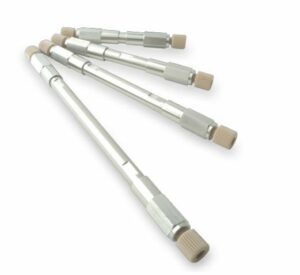Act now to enjoy a limited time offer of 15% off on all Shimadzu Chromatography Columns
Take your research and analysis to the next level and save on Shimadzu HPLC and GC Columns. For a limited period, you can enjoy a remarkable 15% discount off the list price.
Offer available until September 2024

HPLC Columns
Traditional HPLC columns are packed with porous silica particles. Stationary phase chemistry dictates the affinity of the sample components to stick or retain on the column as the mobile phase moves the sample through the column. As a result, the sample components traverse the column and elute at different rates.
The decision of a “best” stationary phase for a separation should be based on sample solubility and the chemical differences between the sample constituents.
Soluble in organic or aqueous solvents?
Knowledge of constituent functional groups? -OH; -COOH; -CONH2; -C6H6, etc.
The decision about the dimensions of the column should be based on the goals for the chromatography.
- Resolution of a critical pair of constituents? – longer column bed
- Fast analysis? – shorter column bed
- Maximum resolution for all? – smaller particles
- Minimize solvent consumption? – narrower inner diameter
- The best choice may be a compromise of different goals.

GC Columns
Short, thick columns made of glass or stainless steel tubes, packed columns have been used since the early stages of gas chromatography.
Packed columns produce broad peak shapes and have low separation performance, but can also handle large sample volumes and are not susceptible to contamination. They are still used today in official analytical methods and for gas analysis.
A typical capillary column is a thin, fused silica glass tube, lined with a liquid phase or adsorbent material or having a chemical bonding layer. Thin metal tubes are also sometimes used as capillary columns.
Selecting columns with polar properties that are close to the polarity of the target compounds
- Analysis of non-polar compounds → Non-polar column
Analysis of polar compounds → Strongly polar column
Selection by analytical objective
- Large difference in boiling point between analytical target compounds → Non-polar column
- Isomers or other compounds with little difference in boiling points → Strongly polar column

